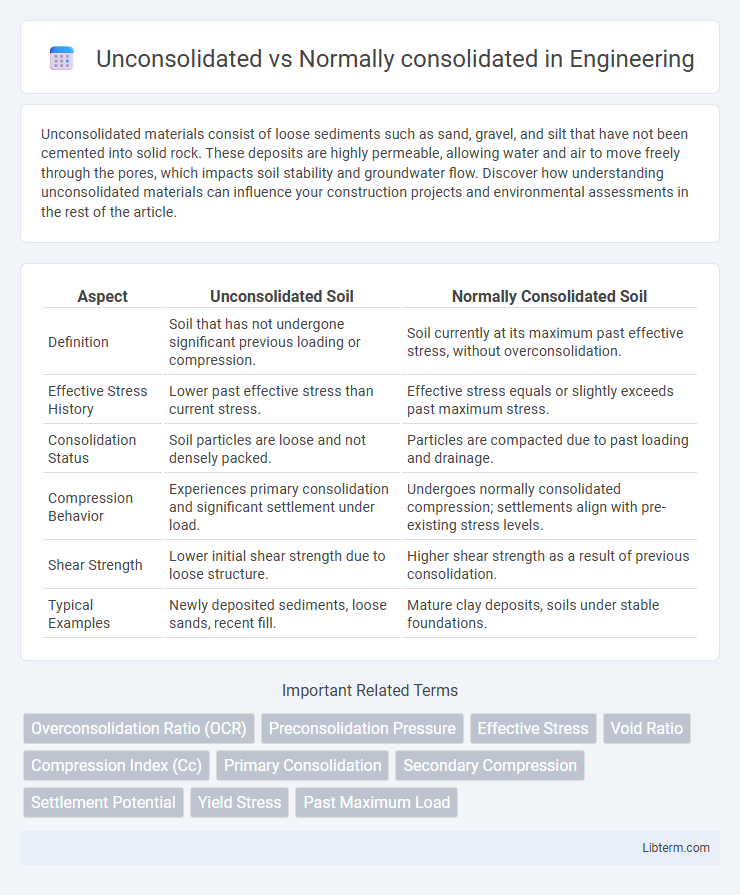Unconsolidated materials consist of loose sediments such as sand, gravel, and silt that have not been cemented into solid rock. These deposits are highly permeable, allowing water and air to move freely through the pores, which impacts soil stability and groundwater flow. Discover how understanding unconsolidated materials can influence your construction projects and environmental assessments in the rest of the article.
Table of Comparison
| Aspect | Unconsolidated Soil | Normally Consolidated Soil |
|---|---|---|
| Definition | Soil that has not undergone significant previous loading or compression. | Soil currently at its maximum past effective stress, without overconsolidation. |
| Effective Stress History | Lower past effective stress than current stress. | Effective stress equals or slightly exceeds past maximum stress. |
| Consolidation Status | Soil particles are loose and not densely packed. | Particles are compacted due to past loading and drainage. |
| Compression Behavior | Experiences primary consolidation and significant settlement under load. | Undergoes normally consolidated compression; settlements align with pre-existing stress levels. |
| Shear Strength | Lower initial shear strength due to loose structure. | Higher shear strength as a result of previous consolidation. |
| Typical Examples | Newly deposited sediments, loose sands, recent fill. | Mature clay deposits, soils under stable foundations. |
Introduction to Soil Consolidation
Soil consolidation refers to the process by which soils decrease in volume over time due to the expulsion of water from their pores under sustained load. Unconsolidated soils have not previously experienced effective stress greater than the current stress, resulting in higher compressibility and lower strength. Normally consolidated soils have undergone maximum past effective stress equal to the current stress, leading to lower compressibility and a more stable soil structure.
Defining Unconsolidated Soils
Unconsolidated soils consist of loose, uncemented particles that have not undergone significant compression or expulsion of pore water under overburden pressure. These soils are characterized by high void ratios and low effective stress, meaning they retain much of their original porosity and are susceptible to large settlements under load. Understanding unconsolidated soils is crucial for geotechnical applications, as their shear strength and compressibility differ significantly from normally consolidated soils, impacting foundation design and slope stability analyses.
Understanding Normally Consolidated Soils
Normally consolidated soils refer to soil layers that have never experienced pressures higher than the existing overburden stress, maintaining natural equilibrium without past overloading. These soils exhibit a linear compression behavior under increasing load, characterized by a consistent compression index during consolidation tests. Understanding normally consolidated soils is crucial for predicting settlement and designing foundations, as their compressibility and strength parameters directly influence soil stability and structural safety.
Key Characteristics of Unconsolidated Soils
Unconsolidated soils are characterized by their loose arrangement of particles and high void ratio, resulting in low shear strength and high compressibility. These soils have not undergone significant pressure-driven compression or expulsion of pore water, distinguishing them from normally consolidated soils. Their structure makes them more susceptible to settlement and deformation under applied loads.
Main Features of Normally Consolidated Soils
Normally consolidated soils have a current effective stress equal to the maximum past effective stress, resulting in no overconsolidation. These soils exhibit virgin compression behavior, with the compression index (Cc) governing the primary consolidation phase. Their permeability and shear strength characteristics reflect the continuous loading history, leading to predictable settlement patterns under applied loads.
Differences Between Unconsolidated and Normally Consolidated Soils
Unconsolidated soils have not undergone significant pressure or time-dependent compression, resulting in higher void ratios and lower strength compared to normally consolidated soils, which have experienced their maximum past pressure and exhibit lower compressibility. Normally consolidated soils show a linear consolidation behavior under load, while unconsolidated soils may display immediate settlement due to their loose structure. The key difference lies in their stress history, influencing permeability, shear strength, and settlement characteristics essential for geotechnical design.
Engineering Properties and Behaviors
Unconsolidated soils exhibit high void ratios and low shear strength due to minimal effective stress history, leading to significant compressibility and potential for large settlements under load. Normally consolidated soils have experienced pressures equal to or greater than current overburden stress, resulting in denser structure, lower compressibility, and higher shear strength. The engineering behavior differences impact foundation design, with unconsolidated soils requiring careful consideration for settlement control and stability.
Importance in Geotechnical Engineering
Unconsolidated and normally consolidated soils differ in their stress history, which critically affects their shear strength and settlement behavior in geotechnical engineering projects. Proper identification of soil consolidation state guides foundation design, slope stability analysis, and predictions of soil deformation under load. Understanding these differences ensures accurate assessment of bearing capacity and long-term performance of earth structures.
Practical Applications and Case Studies
Unconsolidated soils, characterized by high pore water pressure and low shear strength, often require preloading or vertical drains in engineering projects such as embankment construction and land reclamation to enhance stability. Normally consolidated soils, having experienced maximum past pressure equal to current stress, respond predictably to additional loading, making them suitable for foundation design and settlement analysis in urban infrastructure development. Case studies in soft clay deposits demonstrate significant settlement control and reduced construction risk when soil consolidation states are accurately assessed and incorporated into geotechnical design.
Conclusion and Summary
Unconsolidated soils experience undrained conditions with zero effective stress increase, leading to higher pore water pressures and lower shear strength compared to normally consolidated soils. Normally consolidated soils undergo continuous compression and effective stress increase, resulting in greater stability and predictable settlement behavior over time. Understanding these consolidation states is crucial for accurate geotechnical design and soil stability assessment.
Unconsolidated Infographic

 libterm.com
libterm.com